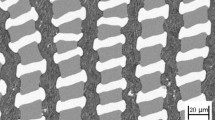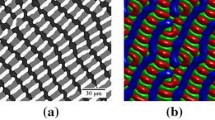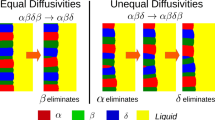Abstract
A simple phase-field model is used to address anisotropic eutectic freezing on the nanoscale in two (2D) and three dimensions (3D). Comparing parameter-free simulations with experiments, it is demonstrated that the employed model can be made quantitative for Ag–Cu. Next, we explore the effect of material properties and the conditions of freezing on the eutectic pattern. We find that the anisotropies of kinetic coefficient and the interfacial free energies (solid–liquid and solid–solid), the crystal misorientation relative to pulling, the lateral temperature gradient play essential roles in determining the eutectic pattern. Finally, we explore eutectic morphologies, which form when one of the solid phases are faceted, and investigate cases, in which the kinetic anisotropy for the two solid phases is drastically different.
















Similar content being viewed by others
References
He G, Eckert J, Löser W, Schultz L (2003) Novel Ti-base nanostructure–dendrite composite with enhanced plasticity. Nat Mater 2:33–37
Louzguine DV, Kato H, Inoue A (2004) High-strength hypereutectic Ti–Fe–Co bulk alloy with good ductility. Philos Mag Lett 84:359–364
Park JM, Kim DH, Kim KB, Kim WT (2007) Deformation-induced rotational eutectic colonies containing length-scale heterogeneity in an ultrafine eutectic Fe83 Ti7 Zr6 B4 alloy. Appl Phys Lett 91:131907–1–131907–3
Park JM, Mattern N, Kühn U, Eckert J, Kim KB, Kim WT, Chattopadhyay K, Kim DH (2009) High-strength bulk Al-based bimodal ultrafine eutectic composite with enhanced plasticity. J Mater Res 24:2605–2609
Samal S, Biswas K (2013) Novel high-strength NiCuCoTiTa alloy with plasticity. J Nanopart Res 15:1783-1–1783-11
Pawlak DA, Kolodziejak K, Turczynski S, Kisielewski J, Rozniatowski K, Diduszko R, Kaczkan M, Malinowski M (2006) Self-organized, rodlike, micrometer-scale micro-structure of Tb3Sc2Al3O12–TbScO3: Pr eutectic. Chem Mater 18:2450–2457
Pawlak DA, Kolodziejak K, Diduszko R, Rozniatowski K, Kaczkan M, Malinowski M, Kisielewski J, Lukasiewicz T (2007) The PrAlO3–Pr2O3 eutectic, its microstructure, instability, and luminescent properties. Chem Mater 19:2195–2202
Pawlak DA, Kolodziejak K, Rozniatowski K, Diduszko R, Kaczkan M, Malinowski M, Piersa M, Kisielewski J, Lukasiewicz T (2008) PrAlO3–PrAl11O18 eutectic: its microstructure and spectroscopic properties. Cryst Growth Des 8:1243–1249
Pawlak DA, Turczynski S, Gajc M, Kolodziejak K, Diduszko R, Rozniatowski K, Smalc J, Vendik I (2010) Metamaterials: How far are we from making metamaterials by self-organization? The microstructure of highly anisotropic particles with an SRR-like geometry. Adv Funct Mater 20:1116–1124
Sadecka K, Gajc M, Orlinski K, Surma HB, Klos A, Joywik-Biala I, Sobczak K, Dluyewski P, Toudert J, Pawlak DA (2015) When eutectics meet plasmonics: nanoplasmonic, volumetric, self-organized, silver-based eutectic. Adv Opt Mater 3:381–389
Kolodziejak K, Gajc M, Rozniatowski K, Diduszko R, Pawlak DA (2016) Synthesis and structural study of a self-organized MnTiO3–TiO2 eutectic. J. Alloys Compd 659:152–158
Merino RI, Acosta MF, Orera VM (2012) New polaritonic materials in the THz range made of directionally solidified halide eutectics. J Eur Ceram Soc 34:2061–2069
Pawlak DA (2008–2012) EU FP7 Collaborative Project ENSEMBLE, CF-FP 213669, Grant Agreement, Annex I. http://cordis.europa.eu/result/rcn/56818_en.html
Oliete PB, Peña JI, Larrea A, Orera VM, Lorca JL, Pastor JY, Martín A, Segurado J (2007) Ultra-high-strength nanofibrillar Al2O3–YAG–YSZ eutectics. Adv Mater 19:2313–2318
Orera VM, Merino RI, Pardo JA, Larrea A, de la Fuente G, Contreras L, Peña JI (2000) Oxide eutectics: role of interfaces in the material properties. Acta Phys Slovaca 50:549–557
Pastor Y, Martin A, Molina-Aldareguia JM, Llorca J, Oliete PB, Larrea A, Peña JI, Orera VM, Arenal R (2013) Superplastic deformation of directionally solidified nanofibrillar Al2O3–Y3Al5O12–ZrO2 eutectics. J Eur Ceram Soc 33:2579–2586
Fullman RL, Wood DJ (1954) Origin of spiral eutectic structures. Acta Metall 2:188–193
Steinbach I (2009) Phase-field models in materials science. Model Simul Mater Sci Eng 17:073001-1–073001-31
Nestler B, Choudhury A (2011) Phase-field modeling of multi-component systems. Curr Opin Solid State and Mater Sci 15:93–105
Akamatsu S, Plapp M (2016) Eutectic and peritectic solidification patterns. Curr Opin Solid State and Mater Sci 20:46–54
Boettinger WJ (2016) The solidification of multicomponent alloys. J Phase Equilib Diffus 37:4–18
Akamatsu S, Bottin-Rousseau S, Serefoglu M, Faivre G (2012) A theory of thin lamellar eutectic growth with anisotropic interphase boundaries. Acta Mater 60:3199–3205
Akamatsu S, Bottin-Rousseau S, Serefoglu M, Faivre G (2012) Lamellar eutectic growth with anisotropic interphase boundaries experimental study using the rotating directional solidification method. Acta Mater 60:3206–3214
Ghosh S, Choudhury A, Plapp M, Bottin-Rousseau S, Faivre G, Akamatsu S (2015) Interphase anisotropy effects on lamellar eutectics: a numerical study. Phys Rev E 91:022407–1–022407–13
Lahiri A, Choudhury A (2015) Effect of surface energy anisotropy on the stability of growth fronts in multiphase alloys. Trans Indian Inst Met 68:1053–1057
Rátkai L, Szállás A, Pusztai T, Mohri T, Gránásy L (2015) Ternary eutectic dendrites: pattern formation and scaling properties. J Chem Phys 142:154501–1–154501–11
Llorca J, Orera V (2006) Directionally solidified eutectic ceramic oxides. Prog Mater Sci 51:711–809
Karma A (2001) Phase-field formulation for quantitative modeling of alloy solidification. Phys Rev Lett 87:115701–1–115701–4
Echebarria B, Folch R, Karma A, Plapp M (2004) Quantitative phase-field model of alloy solidification. Phys Rev E 73:061604–1–061604–22
Hötzer J, Jainta M, Steinmetz P, Nestler B, Dennstedt A, Genau A, Bauer M, Köstler H, Rüde U (2015) Large scale phase-field simulations of directional ternary eutectic solidification. Acta Mater 93:194–204
Folch R, Plapp M (2005) Quantitative phase-field modeling of two-phase growth. Phys Rev E 72:011602–1–011602–27
Kim SG (2007) A phase-field model with antitrapping current for multicomponent alloys with arbitrary thermodynamic properties. Acta Mater 55:4391–4399
Gránásy L, Börzsönyi T, Pusztai T (2002) Nucleation and bulk crystallization in binary phase field theory. Phys Rev Lett 88:206105–1–206105–4
Warren JA, Boettinger WJ (1995) Prediction of dendritc growth and microsegregation patterns in a binary alloy using the phase-field method. Acta Metall Mater 43:689–703
Levitas VI, Warren JA (2016) Phase field approach with anisotropic interface energy and interface stresses: large strain formulation. J Mech Phys Solids 91:94–125
Hoyt JJ, Asta M, Karma A (2003) Atomistic and continuum modeling of dendritic solidification. Mater Sci Eng R 41:121–163
Gránásy L, Pusztai T, Warren JA, Douglas JF, Börzsönyi T, Ferreiro V (2003) Growth of ‘dizzy dendrites’ in a random field of foreign particles. Nat Mater 2:92–96
Gránásy L, Pusztai T, Börzsönyi T, Warren JA, Douglas JF (2004) A general mechanism of polycrystalline growth. Nat Mater 3:645–650
Haxhimali T, Karma A, Gonzales F, Rappaz M (2006) Orientation selection in dendritic evolution. Nat Mater 5:660–664
Davidchack R, Laird BB (2005) Direct calculation of the crystal-melt interfacial free energy via molecular dynamics computer simulation. J Phys Chem B 109:17802–17812
Hoyt JJ, Asta M, Karma A (2001) Method for computing the anisotropy of the solid-liquid interfacial free energy. Phys Rev Lett 86:5530–5533
Majaniemi S, Provatas N (2009) Deriving surface-energy anisotropy for phenomenological phase-field models of solidification. Phys Rev E 79:011607–1–011607–12
Hartel A, Oettel M, Rozas RE, Egelhaff SU, Horbach J, Löwen H (2012) Tension and stiffness of the hard sphere crystal-fluid interface. Phys Rev Lett 108:226101–1–226101–4
Podmaniczky F, Tóth GI, Pusztai T, Gránásy L (2014) Free energy of the bcc-liquid interface and the Wulff shape as predicted by the phase-field crystal model. J Cryst Growth 385:148–153
Tegze G, Bansel G, Tóth GI, Pusztai T, Fan Z, Gránásy L (2009) Advanced operator-splitting-based semi-implicit spectral method to solve the binary phase-field crystal equation with variable coefficients. J Comput Phys 228:1612–1623
Andersson JO, Helander T, Höglund L, Shi PF, Sundman B (2002) Thermo-Calc and DICTRA, computational tools for materials science. Calphad 26:273–312. Thermo-Calc Software, http://www.thermocalc.com/
Gránásy L, Tegze M (1991) Crystal-melt interfacial free energy of elements and alloys. Mater Sci Forum 77:243–256
Singman CN (1984) Atomic volume and allotropy of the elements. J Chem Educ 61:137–142
Cline HE, Lee D (1970) Strengthening of lamellar versus equiaxed Ag–Cu eutectic. Acta Metall 18:315–323
Jackson KA, Hunt JD (1966) Lamellar and rod eutectic growth. Trans Metall Soc AIME 236:1129–1142
Galenko PK, Herlach DM (2006) Diffusionless crystal growth in rapidly solidifying eutectic systems. Phys Rev Lett 96:150602–1–150602–4
Kobayashi R, Giga Y (2001) On anisotropy and curvature effects for growing crystals. Jpn J Ind Appl Math 18:207–230
Jackson KA, Hunt JD (2011) Eutectic solidification in transparent materials, in Jackson KA Crystal Growth (video). Jackson KA (2011) Personal communication
Wang N, Trivedi R (2011) Limit of steady-state lamellar eutectic growth. Scr Mater 64:848–851
Perrut M, Parisi A, Akamatsu S, Botin-Rousseau S, Faivre G, Plapp M (2010) Role of transverse temperature gradients in the generation of lamellar eutectic solidification patterns. Acta Mater 58:1761–1769
Akamatsu S, Perrut M, Bottin-Rousseau S, Faivre G (2010) Spiral two-phase dendrites. Phys Rev Lett 104:056101–1–056101–4
Pusztai T, Rátkai L, Szállás A, Gránásy L (2013) Spiraling eutectic dendrites. Phys Rev E 87:032401–1–032401–4
Akamatsu S, Perrut M, Bottin-Rousseau S, Brener EA (2014) Scaling theory of two-phase dendritic growth in undercooled ternary melts. Phys Rev Lett 112:105502–1–105502–4
Acknowledgements
This work has been supported by the National Agency for Research, Development, and Innovation (NKFIH), Hungary under contract OTKA-K-115959, and by the EU FP7 EU FP7 projects “ENSEMBLE” (Grant Agreement NMP4-SL-2008-213669) and “EXOMET” (contract No. NMP-LA-2012-280421, co-funded by ESA).
Author information
Authors and Affiliations
Corresponding authors
Ethics declarations
Conflict of interest
The authors declare that they have no conflict of interests.
Rights and permissions
About this article
Cite this article
Rátkai, L., Tóth, G.I., Környei, L. et al. Phase-field modeling of eutectic structures on the nanoscale: the effect of anisotropy. J Mater Sci 52, 5544–5558 (2017). https://doi.org/10.1007/s10853-017-0853-8
Received:
Accepted:
Published:
Issue Date:
DOI: https://doi.org/10.1007/s10853-017-0853-8




